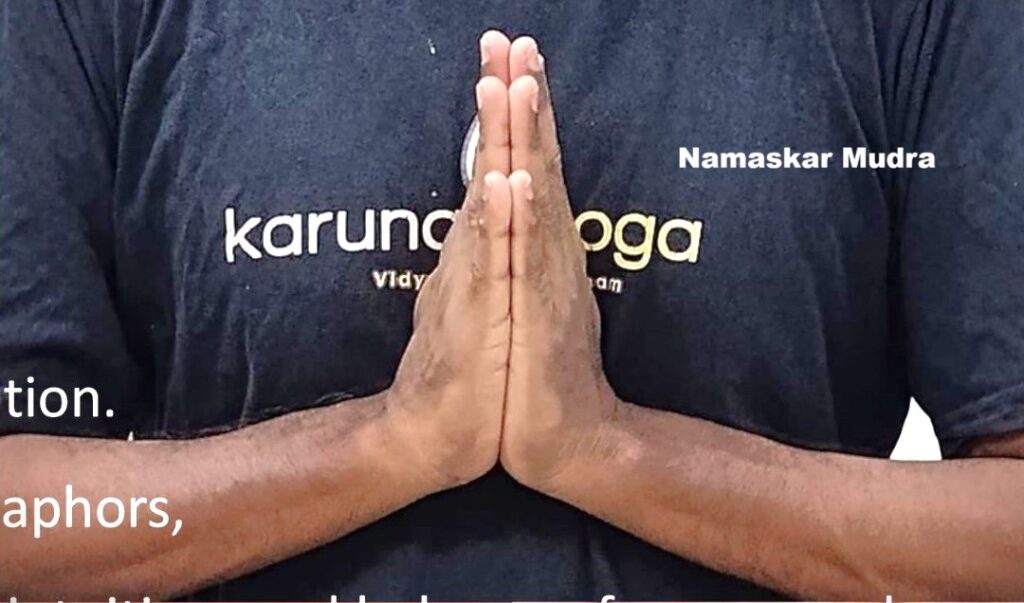Namaskar Mudra
Introduction
Namaskar Mudra (also called Anjali Mudra or Pranam Mudra) is one of the most universal and widely practiced mudras in yoga, spirituality, and daily life. It is the gesture of bringing the palms together at the heart center in a prayer-like position. In yoga, it symbolizes union, humility, gratitude, and balance of energies.
It is used in greetings (Namaste), meditation, and devotional practices, serving as a powerful tool for inner harmony and mindfulness.
Meaning
Namaskar = Salutation, reverence, greeting
Mudra = Gesture or seal
Thus, Namaskar Mudra means the gesture of salutation, representing the acknowledgment of the divine presence in oneself and others.
Symbolically, the joining of palms represents the union of right and left energies (ida & pingala nadis, sun & moon, masculine & feminine, logic & intuition).
How to Perform Practice
Sit or stand comfortably with the spine erect (Sukhasana, Padmasana, Tadasana, or Vajrasana).
Bring both palms together in front of the heart center (Anahata Chakra).
Keep the fingers extended and pressed gently against each other.
Thumbs touch the sternum (heart center) lightly.
Close the eyes and breathe deeply, focusing on gratitude or devotion.
Optionally, bow the head slightly to show humility.
Stay in the mudra for 5–15 minutes, or use it as a gesture at the beginning and end of yoga/meditation practice.
Benefits
Physical Benefits
Improves posture and chest alignment.
Stimulates the heart and lungs, enhancing respiration.
Balances the nervous and cardiovascular systems.
Improves coordination between hands and brain hemispheres.
Mental & Emotional Benefits
Promotes inner calmness and emotional balance.
Reduces stress, anxiety, and restlessness.
Cultivates gratitude, humility, and mindfulness.
Encourages positive emotions and empathy.
Spiritual Benefits
Activates the Anahata (Heart) Chakra, fostering compassion.
Harmonizes ida and pingala nadis, balancing prana.
Serves as a meditative gesture for devotion and prayer.
Helps in centering the mind before meditation or chanting mantras.
Contraindications
Generally safe for all.
People with severe wrist injury, arthritis, or carpal tunnel syndrome may find it difficult to press palms firmly.
Should not be forced if there is shoulder or chest injury.
Anatomy & Physiology
Activates palmar muscles, flexors, and extensors of the hand.
Stretches pectoralis major, deltoids, and intercostal muscles.
Increases blood circulation in the chest region.
Stimulates parasympathetic nervous system, inducing relaxation.
Kinesiology
Involves isometric contraction of hand muscles pressing against each other.
Engages shoulder stabilizers and chest muscles.
Encourages spinal elongation and upright posture.
Enhances bilateral coordination by balancing both hands symmetrically.
Neurology
Calms the autonomic nervous system, reducing stress response.
Activates prefrontal cortex, improving mindfulness and self-awareness.
Stimulates vagus nerve through gentle chest and breath focus.
Enhances right-left hemisphere integration via symmetrical hand position.
Duration of Mudra
General practice: 5–15 minutes daily.
Before/after yoga practice or prayers: 1–2 minutes.
Meditation: Up to 30 minutes with breath awareness.
Counter Mudra
Chin Mudra → for grounding and energy flow.
Hridaya Mudra → for emotional healing.
Jnana Mudra → for wisdom and concentration.
Conclusion
Namaskar Mudra is a universal gesture of respect, unity, and devotion. Beyond being a greeting, it is a yogic practice that harmonizes the body, mind, and spirit. It balances energies, calms the mind, and awakens compassion through heart-centered awareness. Practicing Namaskar Mudra daily can enhance mindfulness, emotional well-being, and spiritual connection.
FAQ
Q1: Is Namaskar Mudra the same as Anjali Mudra?
Yes, they are the same; both refer to the prayer gesture.
Q2: Can it be practiced during meditation?
Yes, it enhances devotion, concentration, and mindfulness.
Q3: Does it have healing properties?
Yes, it reduces stress, balances energy, and calms emotions.
Q4: Can children practice it?
Yes, it is safe for all age groups.
Q5: Which chakra does it activate?
It primarily activates the Heart Chakra (Anahata).
References
Swami Satyananda Saraswati – Asana, Pranayama, Mudra, Bandha
Gertrud Hirschi – Mudras: Yoga in Your Hands
Indu Arora – Mudra: The Sacred Secret
Bihar School of Yoga Publications – Hasta Mudras
B.K.S. Iyengar – Light on Yoga

